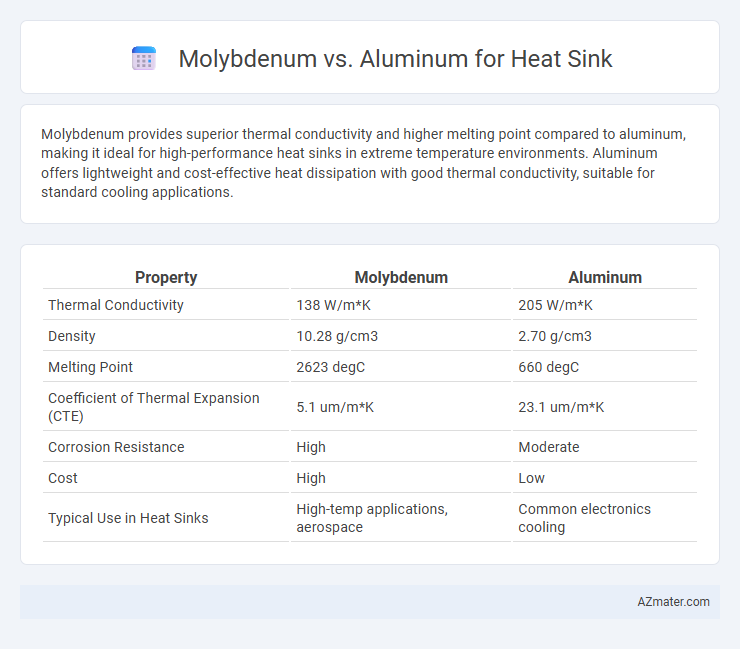Molybdenum provides superior thermal conductivity and higher melting point compared to aluminum, making it ideal for high-performance heat sinks in extreme temperature environments. Aluminum offers lightweight and cost-effective heat dissipation with good thermal conductivity, suitable for standard cooling applications.
Table of Comparison
| Property | Molybdenum | Aluminum |
|---|---|---|
| Thermal Conductivity | 138 W/m*K | 205 W/m*K |
| Density | 10.28 g/cm3 | 2.70 g/cm3 |
| Melting Point | 2623 degC | 660 degC |
| Coefficient of Thermal Expansion (CTE) | 5.1 um/m*K | 23.1 um/m*K |
| Corrosion Resistance | High | Moderate |
| Cost | High | Low |
| Typical Use in Heat Sinks | High-temp applications, aerospace | Common electronics cooling |
Introduction to Heat Sink Materials
Molybdenum and aluminum serve distinct roles in heat sink applications due to their differing thermal conductivities and material properties. Aluminum, known for its excellent thermal conductivity around 205 W/m*K and lightweight characteristics, is widely used in standard heat sinks for efficient heat dissipation. Molybdenum, with a lower thermal conductivity near 138 W/m*K but superior thermal expansion compatibility and mechanical strength, is favored in specialized environments requiring durability and minimal thermal deformation.
Physical and Thermal Properties: Molybdenum vs Aluminum
Molybdenum offers a high melting point of 2,623degC and thermal conductivity around 138 W/m*K, making it suitable for extreme thermal environments, while aluminum has a melting point of 660degC and higher thermal conductivity near 237 W/m*K, enabling efficient heat dissipation in lighter applications. With a density of 10.28 g/cm3, molybdenum is significantly heavier than aluminum's 2.70 g/cm3, impacting the overall weight of heat sinks. The lower coefficient of thermal expansion in molybdenum (about 5 um/m*K) compared to aluminum (around 23 um/m*K) reduces mechanical stress during temperature fluctuations, enhancing structural stability in precision electronics.
Heat Conductivity: Which Material Performs Better?
Molybdenum exhibits a thermal conductivity of approximately 138 W/m*K, which is significantly lower than aluminum's 205 W/m*K, making aluminum the superior choice for heat dissipation in heat sink applications. The higher thermal conductivity of aluminum allows for more efficient heat transfer away from critical components, thus improving thermal management. While molybdenum offers greater mechanical strength and thermal stability at high temperatures, aluminum remains preferred for most heat sinks due to its optimal balance of conductivity, weight, and cost.
Weight and Density Comparison
Molybdenum has a density of approximately 10.28 g/cm3, significantly higher than aluminum's 2.70 g/cm3, making aluminum much lighter for heat sink applications. The lower weight of aluminum contributes to easier handling and reduced overall system mass, which is critical in aerospace and portable electronics. Despite molybdenum's superior thermal conductivity and high melting point, its higher density results in heavier heat sinks that may not be suitable where weight reduction is a priority.
Corrosion Resistance and Durability
Molybdenum offers superior corrosion resistance compared to aluminum, making it ideal for environments prone to oxidation and chemical exposure. Its high melting point and exceptional durability ensure consistent thermal performance under extreme conditions. Aluminum, while lightweight and cost-effective, is more susceptible to corrosion, requiring additional coatings to enhance its longevity in harsh settings.
Cost Analysis: Molybdenum vs Aluminum
Molybdenum heat sinks typically incur higher initial material costs compared to aluminum due to molybdenum's rarity and complex extraction process. Aluminum offers a cost-effective alternative with lower raw material and manufacturing expenses, making it favorable for large-scale production. However, molybdenum's superior thermal conductivity and durability can justify the premium in high-performance or specialized applications, potentially reducing long-term operational costs.
Manufacturing and Machinability Differences
Molybdenum offers superior thermal conductivity and high-temperature stability compared to aluminum but presents greater challenges in manufacturing due to its hardness and brittleness, requiring specialized machining techniques such as wire EDM or grinding. Aluminum's softness and excellent machinability enable faster production with standard CNC milling, making it more cost-effective for mass-produced heat sinks. Manufacturing efficiency and tooling costs are significantly higher for molybdenum, whereas aluminum allows for easier extrusion and complex geometries, enhancing design flexibility in heat sink applications.
Application Suitability in Electronics and Industry
Molybdenum offers superior thermal conductivity and high melting points, making it ideal for high-performance electronics requiring efficient heat dissipation under extreme conditions. Aluminum, with its lightweight and excellent corrosion resistance, is preferred in mass-produced electronic devices and industrial applications where cost and weight are critical factors. Electronics and industry choose molybdenum for high-temperature environments, while aluminum suits applications prioritizing weight efficiency and affordability.
Environmental Impact and Recyclability
Molybdenum offers superior thermal conductivity and durability with a lower environmental impact due to its high recyclability rate, often exceeding 90%, minimizing mining waste and energy consumption. Aluminum, while highly recyclable at rates above 85%, requires more energy-intensive refining processes and emits significant greenhouse gases during production. The choice between molybdenum and aluminum for heat sinks hinges on balancing aluminum's lightweight properties against molybdenum's eco-friendly, sustainable lifecycle benefits.
Final Recommendations: Choosing the Right Heat Sink Material
Molybdenum offers superior thermal conductivity and higher melting point, making it ideal for high-temperature applications requiring durability and efficient heat dissipation. Aluminum excels in lightweight, cost-effective heat sinks with good thermal performance, suitable for standard electronics and consumer devices. Select molybdenum for heavy-duty, precision cooling needs, while aluminum fits best for general-purpose, affordable heat sink solutions.

Infographic: Molybdenum vs Aluminum for Heat Sink
 azmater.com
azmater.com